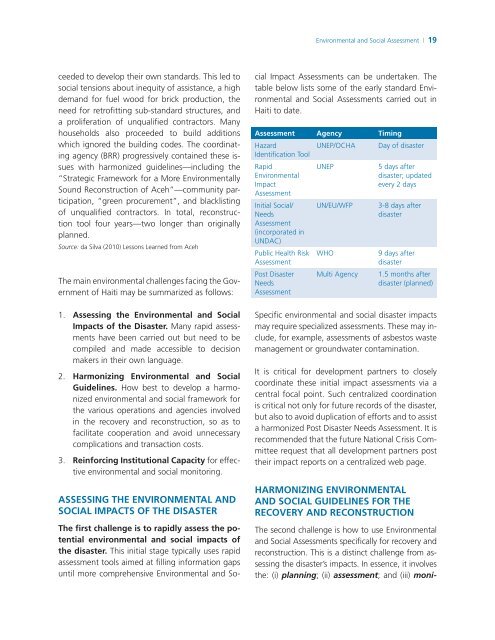Haiti Earthquake Reconstruction Knowledge Notes from ... - GFDRR
Haiti Earthquake Reconstruction Knowledge Notes from ... - GFDRR
Haiti Earthquake Reconstruction Knowledge Notes from ... - GFDRR
You also want an ePaper? Increase the reach of your titles
YUMPU automatically turns print PDFs into web optimized ePapers that Google loves.
Environmental and Social Assessment | 19<br />
ceeded to develop their own standards. This led to<br />
social tensions about inequity of assistance, a high<br />
demand for fuel wood for brick production, the<br />
need for retrofitting sub-standard structures, and<br />
a proliferation of unqualified contractors. Many<br />
households also proceeded to build additions<br />
which ignored the building codes. The coordinating<br />
agency (BRR) progressively contained these issues<br />
with harmonized guidelines—including the<br />
“Strategic Framework for a More Environmentally<br />
Sound <strong>Reconstruction</strong> of Aceh”—community participation,<br />
“green procurement”, and blacklisting<br />
of unqualified contractors. In total, reconstruction<br />
tool four years—two longer than originally<br />
planned.<br />
Source: da Silva (2010) Lessons Learned <strong>from</strong> Aceh<br />
The main environmental challenges facing the Government<br />
of <strong>Haiti</strong> may be summarized as follows:<br />
1.<br />
2.<br />
Assessing the Environmental and Social<br />
Impacts of the Disaster. Many rapid assessments<br />
have been carried out but need to be<br />
compiled and made accessible to decision<br />
makers in their own language.<br />
Harmonizing Environmental and Social<br />
Guidelines. How best to develop a harmonized<br />
environmental and social framework for<br />
the various operations and agencies involved<br />
in the recovery and reconstruction, so as to<br />
facilitate cooperation and avoid unnecessary<br />
complications and transaction costs.<br />
3. Reinforcing Institutional Capacity for effective<br />
environmental and social monitoring.<br />
ASSESSING THE ENVIRONMENTAL AND<br />
SOCIAL IMPACTS OF THE DISASTER<br />
The first challenge is to rapidly assess the potential<br />
environmental and social impacts of<br />
the disaster. This initial stage typically uses rapid<br />
assessment tools aimed at filling information gaps<br />
until more comprehensive Environmental and Social<br />
Impact Assessments can be undertaken. The<br />
table below lists some of the early standard Environmental<br />
and Social Assessments carried out in<br />
<strong>Haiti</strong> to date.<br />
Assessment Agency Timing<br />
Hazard<br />
UNEP/OCHA Day of disaster<br />
Identification Tool<br />
Rapid<br />
Environmental<br />
Impact<br />
Assessment<br />
UNEP<br />
5 days after<br />
disaster; updated<br />
every 2 days<br />
Initial Social/<br />
Needs<br />
Assessment<br />
(incorporated in<br />
UNDAC)<br />
Public Health Risk<br />
Assessment<br />
Post Disaster<br />
Needs<br />
Assessment<br />
UN/EU/WFP<br />
WHO<br />
Multi Agency<br />
3-8 days after<br />
disaster<br />
9 days after<br />
disaster<br />
1.5 months after<br />
disaster (planned)<br />
Specific environmental and social disaster impacts<br />
may require specialized assessments. These may include,<br />
for example, assessments of asbestos waste<br />
management or groundwater contamination.<br />
It is critical for development partners to closely<br />
coordinate these initial impact assessments via a<br />
central focal point. Such centralized coordination<br />
is critical not only for future records of the disaster,<br />
but also to avoid duplication of efforts and to assist<br />
a harmonized Post Disaster Needs Assessment. It is<br />
recommended that the future National Crisis Committee<br />
request that all development partners post<br />
their impact reports on a centralized web page.<br />
HARMONIZING ENVIRONMENTAL<br />
AND SOCIAL GUIDELINES FOR THE<br />
RECOVERY AND RECONSTRUCTION<br />
The second challenge is how to use Environmental<br />
and Social Assessments specifically for recovery and<br />
reconstruction. This is a distinct challenge <strong>from</strong> assessing<br />
the disaster’s impacts. In essence, it involves<br />
the: (i) planning; (ii) assessment; and (iii) moni-

















